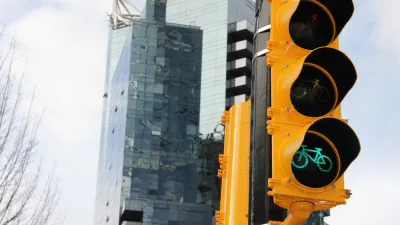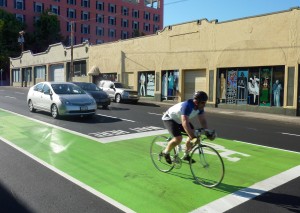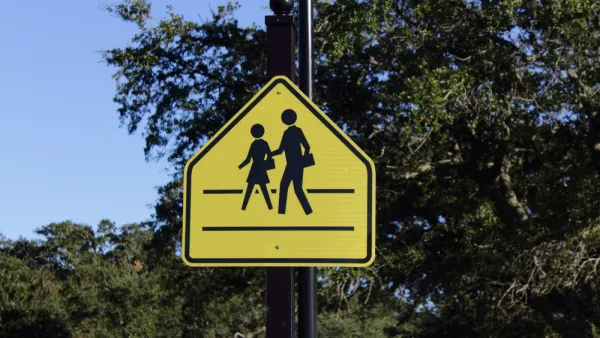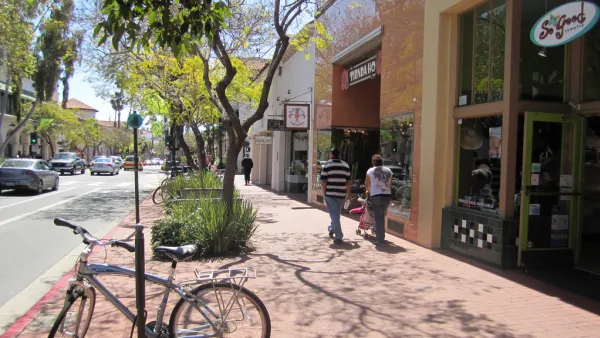Bike boxes and bike traffic signals can greatly assist cyclists in navigating through intersections where the majority of bike-motor vehicle collisions occur. A key advisory committee may recommend official acceptance, which would green-light them.

These two innovative bike infrastructure devices used by some bike-friendly U.S. cities and more widely used in Europe "are not fully recognized by one of the country’s most important engineering guides," writes Angie Schmitt. "But there are new signs that these two treatments are on their way to official acceptance from the engineering establishment."
Image: Otrec
"Bike boxes and bike signals are currently classified as 'experimental' in the Manual on Uniform Traffic Control Devices — which stops many local agencies from installing them. But there are new signs that these two treatments are on their way to official acceptance from the engineering establishment," writes Schmitt.
According to its website, "(t)he Manual on Uniform Traffic Control Devices, or MUTCD defines the standards used by road managers nationwide to install and maintain traffic control devices on all public streets, highways, bikeways, and private roads open to public traffic. The MUTCD is published by the Federal Highway Administration..."
The value of bike boxes and traffic lights is demonstrated at intersections. "Analyses of motor vehicle and police-reported crash data reveal that nearly 68 percent of bicycle crashes in Portland, Oregon occur at intersections (PDOT, 2004) which is consistent with national trends (Hunter et al., 1996)", according to OTREC, "a partnership between Portland State University, the University of Oregon, Oregon State University and the Oregon Institute of Technology."
According to Streetswiki, "the bike box is a 14-foot wide rectangle marked in front of the stop line for motorists, but behind the pedestrian crosswalk. (It) provides room for several bicyclists (and is) used in conjunction with bike lanes, from which bicyclists pedal directly into the box. The boxes have no intended function when traffic is already in motion."
Bike boxes work best at intersections with a high volume of bicyclists. They improve cyclists' visibility. They reduce delay for cyclists by providing space for "jumping the queue" of waiting vehicles. They allow a left-turning bicyclist to reach a better position for making a safe turn. They allow bicyclists to reduce exposure to vehicle tailpipe emissions, and are also thought to elevate the "status" of bicyclists relative to motor vehicles.
The "National Association of City Transportation Officials (NACTO) has provided detailed information and guidance for appropriate locations to install bicycle signal heads," as we noted in January.
Schmitt writes that an advisory group may recommend updates to the MUTCD to sanction use of bike boxes and traffic signals, currently considered experimental, at its January meeting.
MUTCD approval “gives cities interested in these tools permission to use them,” said Darren Flusche, policy director at the League of American Bicyclists. “It will help traffic engineers in those cities sleep easier at night knowing that the treatment is officially approved.”
NACTO provides additional intersection treatments for transportation planners and engineers to consider.
FULL STORY: Engineering Establishment Poised to Endorse Bike Boxes and Bike Signals

National Parks Layoffs Will Cause Communities to Lose Billions
Thousands of essential park workers were laid off this week, just before the busy spring break season.

Retro-silient?: America’s First “Eco-burb,” The Woodlands Turns 50
A master-planned community north of Houston offers lessons on green infrastructure and resilient design, but falls short of its founder’s lofty affordability and walkability goals.

Delivering for America Plan Will Downgrade Mail Service in at Least 49.5 Percent of Zip Codes
Republican and Democrat lawmakers criticize the plan for its disproportionate negative impact on rural communities.

Test News Post 1
This is a summary

Test News Headline 46
Test for the image on the front page.

Balancing Bombs and Butterflies: How the National Guard Protects a Rare Species
The National Guard at Fort Indiantown Gap uses GIS technology and land management strategies to balance military training with conservation efforts, ensuring the survival of the rare eastern regal fritillary butterfly.
Urban Design for Planners 1: Software Tools
This six-course series explores essential urban design concepts using open source software and equips planners with the tools they need to participate fully in the urban design process.
Planning for Universal Design
Learn the tools for implementing Universal Design in planning regulations.
EMC Planning Group, Inc.
Planetizen
Planetizen
Mpact (formerly Rail~Volution)
Great Falls Development Authority, Inc.
HUDs Office of Policy Development and Research
NYU Wagner Graduate School of Public Service





























